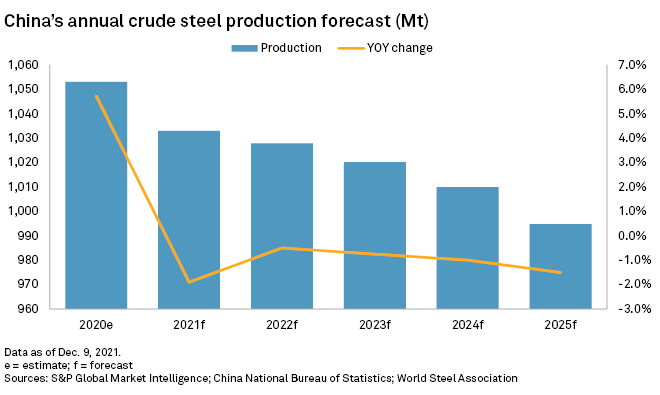
A power plant in Chinese steel hub Tangshan in Hebei province, about 150 km from Beijing. Hebei is projected to cut steel output by up to 30% during the upcoming Winter Olympics. |
China's efforts to ensure "blue skies" for the upcoming Winter Olympics will constrain steel, zinc and aluminum production through March, but the effect will fade with the end of the country's curtailments.
To improve air quality during the Beijing Winter Olympic and Paralympic Games, scheduled from Feb. 4 to March 13, China's Ministry of Ecology and Environment included more cities in its annual winter antipollution campaign in September 2021. A total of 64 cities near Beijing and co-host city Zhangjiakou are subject to stringent environmental regulations from Oct. 1, 2021, to Mar. 31, 2022, up from 28 cities in the past few years. The affected provinces include Hebei, China's biggest steel producer, as well as coal mining hub Shanxi, and key aluminum producers Shandong and Henan.
As a result of the antipollution orders, China's crude steel production dropped 6.8% and primary aluminum output was down by 4% in December 2021, according to the National Bureau of Statistics. Refined zinc output is estimated to have fallen by 7.3% in the same month, according to metals research firm Shanghai Metals Market. China is the world's top producer of steel, zinc and aluminum. The reductions have contributed to swings and price spikes in those markets, and other metals have also had supply issues.

Several alumina refineries and copper smelters in the Henan and Shandong provinces have been asked to curb output to reduce emissions during the Olympics, according to S&P Global Platts. Three-month aluminum prices on the London Metal Exchange have risen about 10% in 2022, to $3,111 per tonne as of Jan. 20, in part due to China's supply cuts and problems for European smelters struggling with volatile natural gas prices.
Lithium carbonate production has also been restricted in Hebei and Shandong, Shanghai Metals Market reported.
Pollution controls also are likely to exacerbate supply disruptions in the zinc market in the first quarter, which is already under threat of power issues in Europe, Tom Mulqueen, head of research with Amalgamated Metal Trading, said in an interview. Market Intelligence lowered its 2022 forecast for Chinese refined zinc output to 6.8 million tonnes, representing a 3.0% increase over 2021, with growth stunted by power limitations and emissions targets. The London Metal Exchange three-month zinc price closed at $3,649.5/t on Jan. 20, the highest level since reaching a 14-year high in October 2021.
Steel production also took a hit as mills slowed to reduce pollution, and the upcoming Lunar New Year in February could push supply down further.
"I would expect steel mills will run at an even slower pace this year," Market Intelligence analyst Yao Shunyu said in an email.
The constraint on the steel industry has been limiting graphite demand, Benchmark Mineral Intelligence analyst George Miller said in an interview. Graphite mining in Shandong has been curbed due to the Olympics. But overall production has not been affected as much as some other industries because most mines tend to shut down during winter given cold temperatures, Miller said.

Part of a bigger picture
The Olympics' effect on supply will only have a short duration, and metals markets are already looking past the end of the games, when production is expected to rebound.
After the Olympics, "we still need to come back to fundamental demand-supply," James Kan, head of Asia basic materials research at UBS Investment Bank, said in a webinar. The production resumption will likely be faster than the demand resumption due to falling coal prices and the downturn in the property sector, Kan said.
"The 'cut' has already happened," Market Intelligence's Yao said. Most steel mills in Hebei have been cutting production since September 2021, after the local government set a target to cut 21.7 Mt of annual crude steel output in August 2021, which is 8.7% lower than 2020 output, the analyst said.
"Prices have to a large extent already reacted positively to the [Olympics'] resulting tightness," Hansen said, adding that the long-term impact might be limited, as China is gearing up for another round of stimulus that may help offset slowing demand related to the property sector.
The effect of the Olympics on production will be dwarfed in the long run by larger forces at play in China's economics. The country's decarbonization drive and

China is planning to reduce capacities of key raw materials, decrease steel energy consumption by 2% and reduce carbon emissions of electrolytic aluminum by 5% by 2025, the Ministry of Industry and Information Technology announced in late December 2021.
"There's a broader picture around decarbonization that affects steel more than any attempts to control pollution around the Olympics," said Ronnie Cecil, principal Market Intelligence analyst for iron ore and steel. "China cut steel production [in 2021], and they will likely do so again this year, and other than some slow down around February, the Olympics won't have much impact."
S&P Global Platts and S&P Global Market Intelligence are owned by S&P Global Inc.



